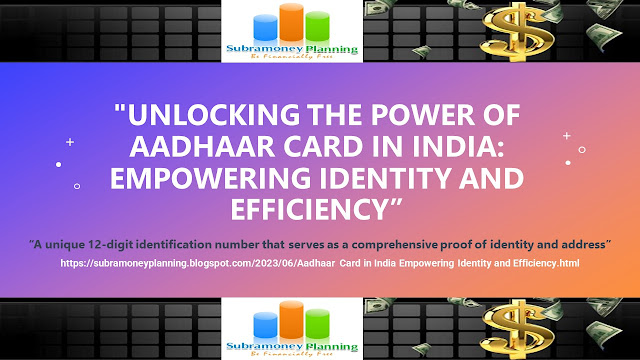“A unique 12-digit identification number that serves as a
comprehensive proof of identity and address”
In a rapidly digitizing world, the Aadhaar Card has emerged as a significant milestone in India's pursuit of a robust and inclusive identification system. Introduced in 2009, the Aadhaar Card is a unique 12-digit identification number that serves as a comprehensive proof of identity and address. This blog post delves into the features, scenarios, advantages, and disadvantages of the Aadhaar Card in India. Furthermore, we will explore key takeaways that shed light on its impact and significance.
 |
| Aadhaar Card in India: Empowering Identity and Efficiency Subramoneyplanning |
Features and Key Components of Aadhaar Card
The Aadhaar Card comes with several features that make it a versatile and powerful identity document. Some of its notable features include:
1. Unique Identification: Each Aadhaar Card is assigned a unique 12-digit number, ensuring that no two individuals have the same identity.
2. Biometric Authentication: Aadhaar utilizes biometric data, such as fingerprints and iris scans, for accurate and secure authentication, reducing the chances of fraud and identity theft.
3. Inclusive Coverage: Aadhaar is designed to encompass every resident of India, irrespective of age, gender, or nationality. This ensures that marginalized sections of society can access government schemes and services without facing identity-related hurdles.
4. Online Verification: The Aadhaar Card can be quickly verified online, making it convenient for individuals and organizations to authenticate identities in real-time. This feature finds immense utility in various scenarios, such as banking, e-governance, and telecom services.
5. Mobile Integration: Aadhaar enables mobile verification through the Mobile Aadhaar app, eliminating the need for carrying physical cards and allowing for hassle-free access to services on-the-go.
6. QR Code: The Aadhaar Card features a QR (Quick Response) code, which contains encrypted information that can be scanned and verified electronically. The QR code simplifies the process of authentication and verification of Aadhaar details.
7. Aadhaar Number: The Aadhaar Card prominently displays the unique 12-digit Aadhaar number assigned to the individual. This number is necessary for availing government schemes, opening bank accounts, and other services that require Aadhaar verification.
8. Photograph: The Aadhaar Card includes a recent photograph of the cardholder. The photograph serves as a visual identification and helps confirm the identity of the individual.
9. Digital Signature: The Aadhaar Card incorporates a digital signature from the issuing authority, ensuring its authenticity and validity. The digital signature helps establish the genuineness of the card and the information it contains.
10. Issue and Expiry Date: The Aadhaar Card displays the date of issuance and, if applicable, the date of expiry. The card is valid for a lifetime, and the dates provide reference points for administrative purposes.
11. Validity: The Aadhaar Card is considered a valid identification document accepted across various government and private sector entities for identification and verification purposes.
12. Mobile Number and Email ID (Optional): Individuals have the option to provide their mobile number and email ID during Aadhaar enrollment. This information can be linked to the Aadhaar Card and used for communication and updates related to Aadhaar services.
13. Demographic Information: The Aadhaar Card contains essential demographic details of the cardholder, such as their name, date of birth, gender, and address. This information helps establish the individual's identity and residence.
Advantages of Aadhaar Card
1. Streamlined Identification: Aadhaar card allows individuals to easily verify their identity for services like SIM card activation or opening a new bank account, simplifying the identification process and reducing paperwork.
Example: Mr. Sharma used his Aadhaar card to open a bank account, eliminating the need to provide multiple identification documents and making the process quick and hassle-free.
2. Targeted Welfare Programs: Aadhaar card ensures that government welfare benefits are directed to the intended recipients, preventing leakage and ensuring that the benefits reach those who truly need them.
Example: Rani, a single mother, received cooking gas subsidies directly into her bank account through Aadhaar-linked DBT, eliminating intermediaries and ensuring she receives the full benefit amount.
3. Financial Inclusion: Aadhaar card enables individuals without traditional identification documents to access banking services, promoting financial inclusion and empowering marginalized communities.
Example: Rajesh, a daily wage worker, was able to open a bank account using his Aadhaar card, providing him with a safe and convenient way to save money and access financial services.
4. Simplified KYC Process: Aadhaar card serves as a valid proof of identity for various services, simplifying the Know Your Customer (KYC) process and reducing the documentation requirements.
Example: Meera, a student, easily applied for a mobile phone connection by providing her Aadhaar card as a KYC document, eliminating the need for additional paperwork.
5. Direct Benefit Transfer: Aadhaar card facilitates direct transfer of subsidies and benefits to the bank accounts of beneficiaries, ensuring timely delivery and reducing corruption and leakage.
Example: The DBT scheme, powered by Aadhaar, has successfully eliminated leakages in the public distribution system. It enables direct cash transfers to the bank accounts of beneficiaries, minimizing corruption and ensuring the timely provision of subsidies.
6. Reduced Identity Fraud: Aadhaar card's biometric authentication system makes it difficult for individuals to impersonate others, reducing the instances of identity fraud and ensuring the security of personal information.
Example: Aaditya, an employer, uses Aadhaar-based biometric authentication to verify the identity of his employees, minimizing the risk of identity fraud and creating a secure work environment.
7. Efficient Governance and Service Delivery: Aadhaar card enables the government to efficiently manage and deliver public services, reducing paperwork, eliminating duplication, and improving the speed and accuracy of service delivery.
Example: The Aadhaar-enabled e-KYC system has revolutionized the process of availing government services. Individuals can now digitally verify their identity, simplifying administrative processes and reducing paperwork.
8. Digital Empowerment: Aadhaar card acts as a foundation for various digital initiatives, allowing individuals to access e-services, file tax returns, or avail online services, promoting digital empowerment and convenience.
Example: With Aadhaar-based authentication, Geeta can now file her income tax returns online, eliminating the need for manual paperwork and saving her time and effort.
9. Enhanced Security and Privacy: Aadhaar card incorporates robust security measures, protecting personal information and ensuring the privacy and confidentiality of individuals' data.
Example: Aadhaar card's encryption and stringent security protocols safeguard personal data, providing individuals with the assurance that their information is secure and protected.
10. Promotes Inclusive Development: Aadhaar card bridges the gap between the privileged and underprivileged, providing a unique identification system that enables equal access to services and benefits, fostering inclusive development.
Example: Aadhaar card allows people from marginalized communities to avail government schemes and subsidies, promoting inclusive development and reducing socio-economic disparities.
1. Privacy Concerns: Aadhaar has faced criticism regarding privacy issues and the potential misuse of personal data. The centralization of data raises concerns about surveillance and unauthorized access, although the government has taken steps to address these concerns.
Example: In 2018, the Supreme Court of India ruled that Aadhaar cannot be made mandatory for certain services to safeguard individuals' privacy and limit the scope of data collection.
2. Exclusion of Marginalized Sections: The mandatory linkage of Aadhaar to essential services sometimes creates hurdles for individuals who lack proper documentation or biometric records. This can exclude marginalized communities from availing government schemes and services.
Example: Some reports indicate instances where individuals were denied access to welfare programs due to technical issues or discrepancies in their Aadhaar data, leading to exclusion from vital benefits.
3. Possibility of Identity Theft: While Aadhaar aims to prevent identity theft, no system is entirely foolproof. Biometric data, if compromised, can be misused, leading to potential identity theft and financial fraud.
Example: In 2018, a newspaper report highlighted the potential vulnerability of Aadhaar data, which could be acquired for a nominal fee, raising concerns about the security and integrity of the system.
4. Technological Challenges: Aadhaar's effectiveness relies on a robust technological infrastructure, including network connectivity and reliable biometric authentication devices. In remote areas or during system outages, individuals may face difficulties in accessing services.
Example: Poor network connectivity in rural areas can hamper real-time Aadhaar verification, leading to delays or denials in service provision.
5. Possibility of Misuse by Unauthorized Entities: Despite safeguards, there have been instances where unauthorized entities have misused Aadhaar data for unauthorized purposes. Such incidents highlight the need for continued vigilance and stringent measures to prevent misuse.
Example: Cases of fraudulent SIM card activations using stolen Aadhaar data have been reported, indicating potential risks associated with the unauthorized use of Aadhaar information.
Key Takeaways
1. Aadhaar Card has transformed the identity landscape in India, enabling streamlined service delivery, financial inclusion, and improved governance.
2. The biometric authentication and online verification features of Aadhaar have facilitated secure and efficient access to government services and schemes.
3. Aadhaar has played a pivotal role in India's digital transformation, paving the way for a digitally empowered society and fostering economic growth.
4. Concerns regarding privacy, exclusion, identity theft, technological challenges, and misuse underline the need for continuous monitoring, safeguards, and improvements in the Aadhaar ecosystem.
5. The advantages of Aadhaar, including reduced corruption, financial inclusion, improved governance, digital empowerment, and enhanced security, outweigh its disadvantages, indicating its positive impact on Indian society.
6. Ongoing efforts are necessary to address privacy concerns, ensure inclusivity, bolster security measures, and strengthen the technological infrastructure supporting Aadhaar.
7. Public awareness campaigns and education initiatives can help individuals understand the benefits, rights, and responsibilities associated with Aadhaar.
8. Striking a balance between convenience, security, and privacy should be a priority while evolving the Aadhaar ecosystem.
9. International collaborations and sharing of best practices can contribute to the development and improvement of robust identity systems globally.
10. Aadhaar's journey showcases the potential of a digital identity framework in empowering citizens, enhancing governance, and driving socio-economic progress.
The Aadhaar Card has emerged as a game-changer in India's pursuit of an inclusive and efficient identification system. Despite certain challenges, its features, advantages, and positive impact on governance, financial inclusion, and digital empowerment cannot be undermined. By continuously addressing concerns, safeguarding privacy, and enhancing security measures, the Aadhaar ecosystem can further strengthen its position as a reliable and effective identity framework. As technology evolves, Aadhaar should adapt and stay relevant to ensure that it continues to benefit millions of individuals and drive India's journey towards a digitally empowered society.






0 comments:
Post a Comment